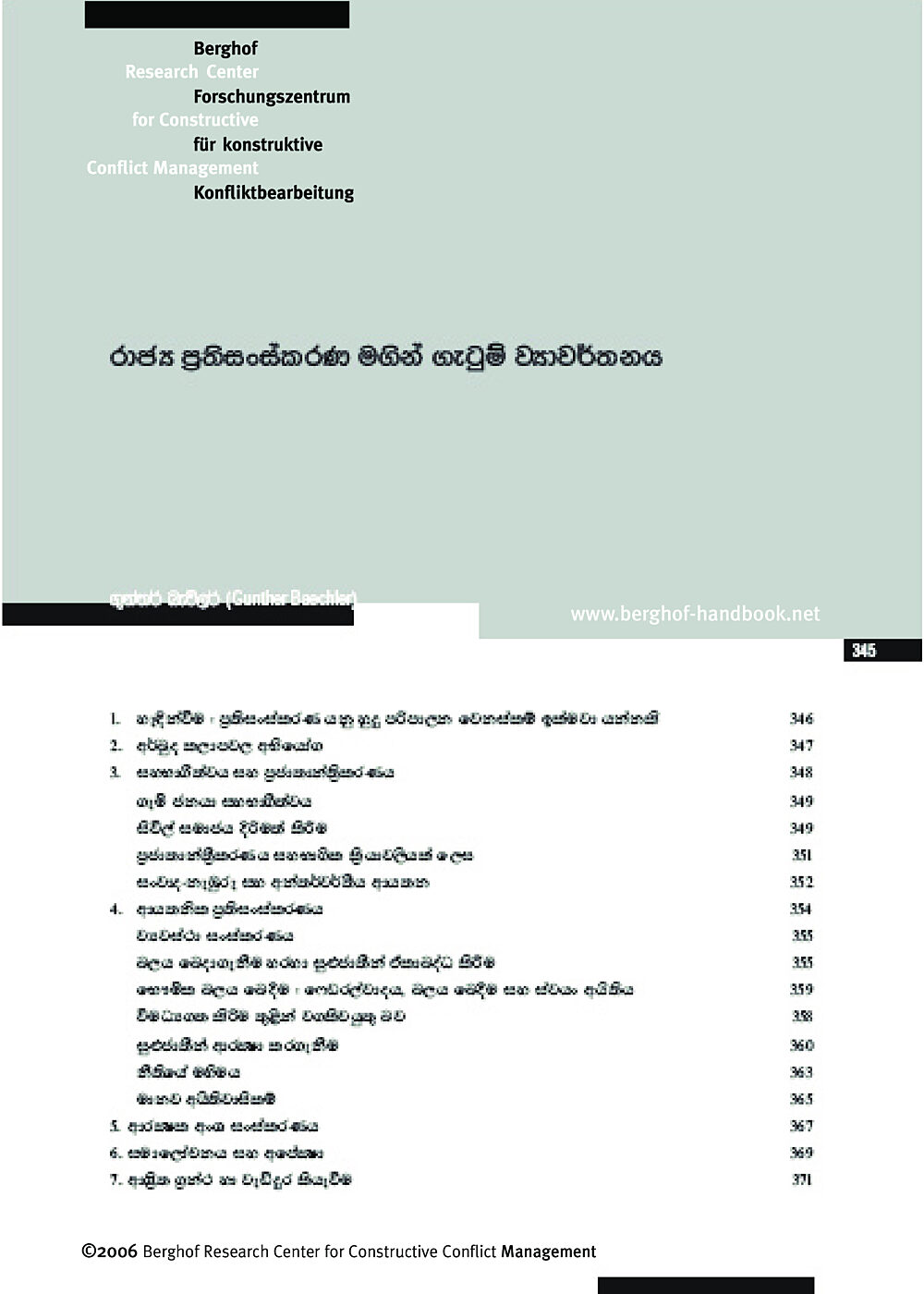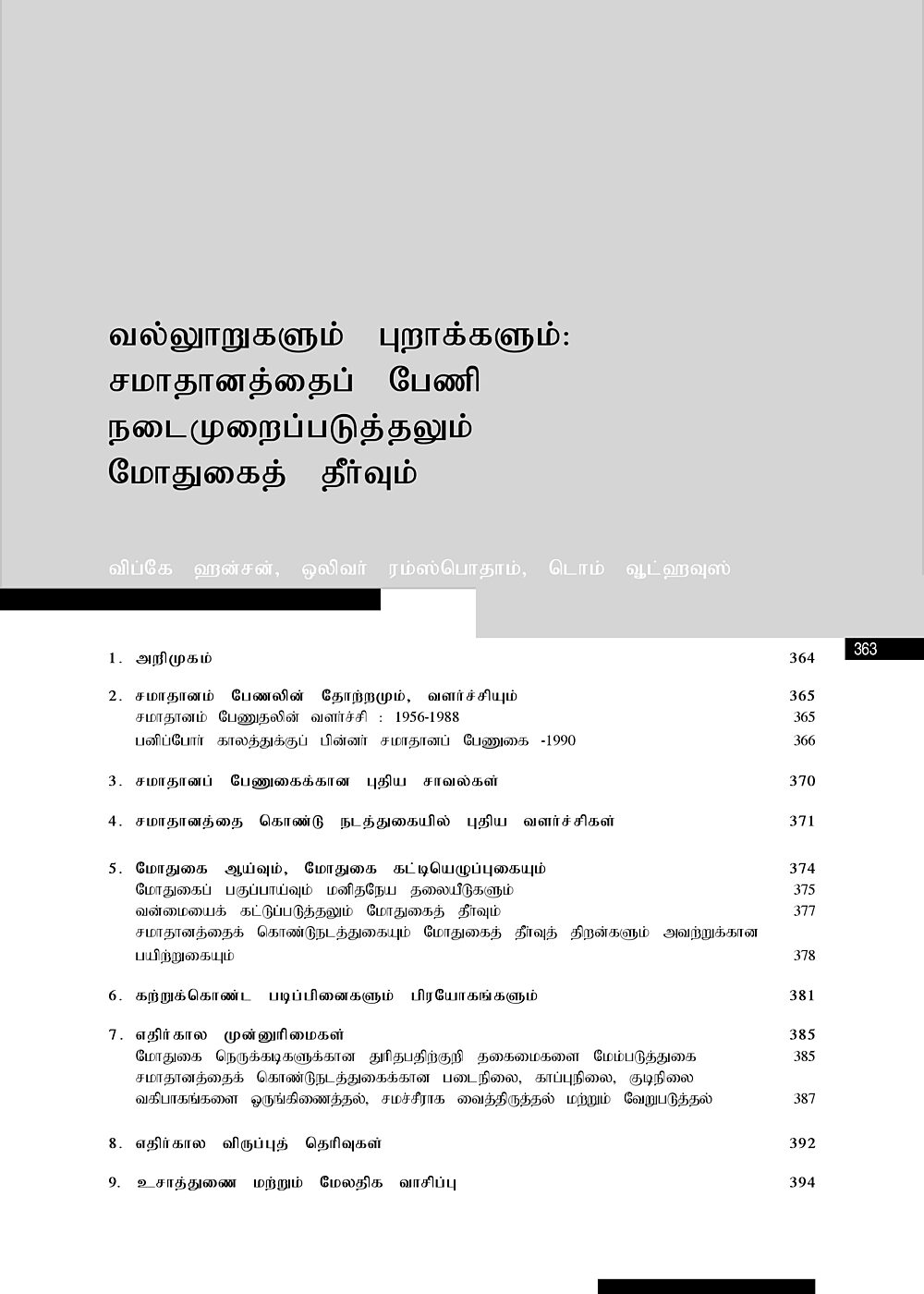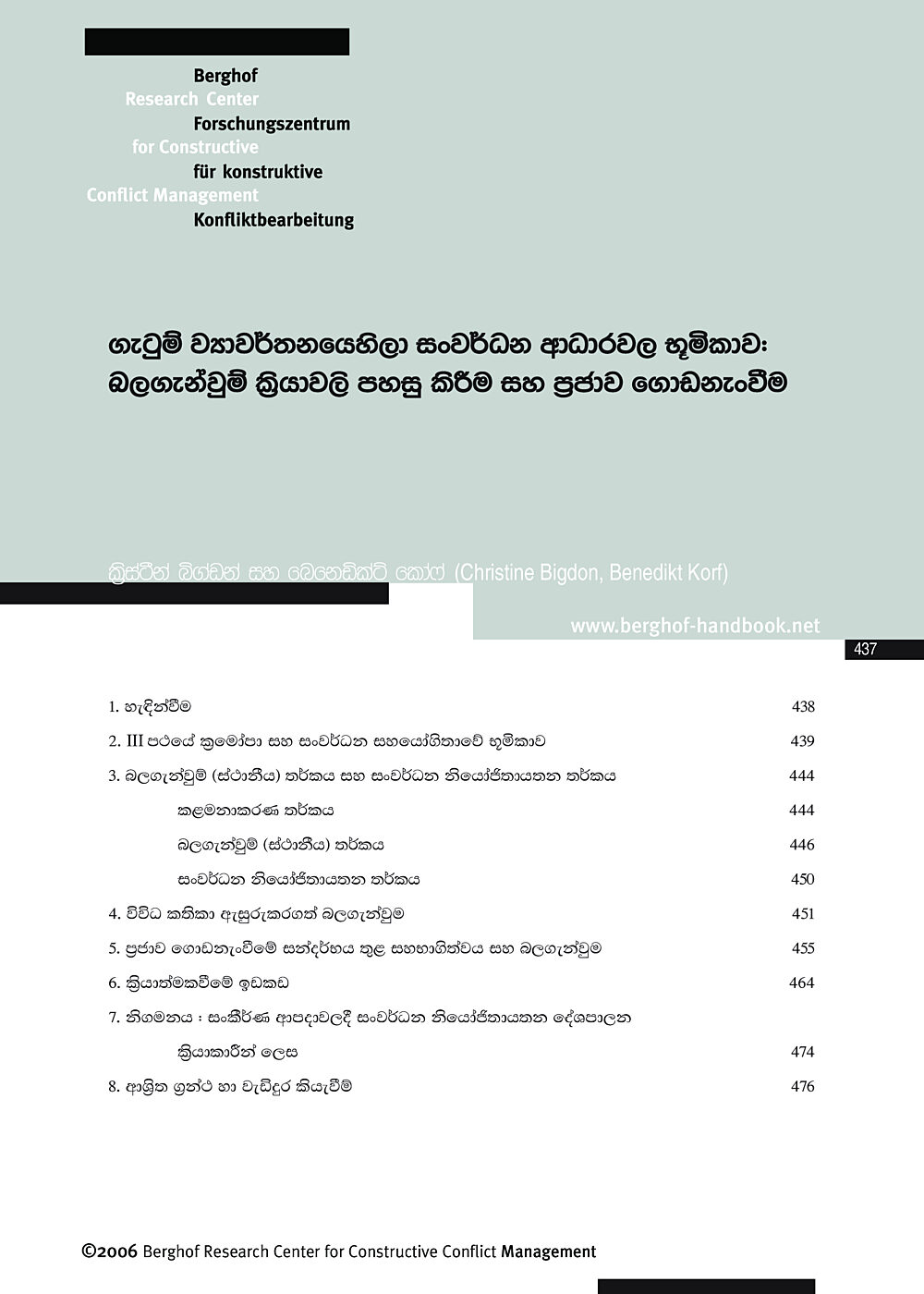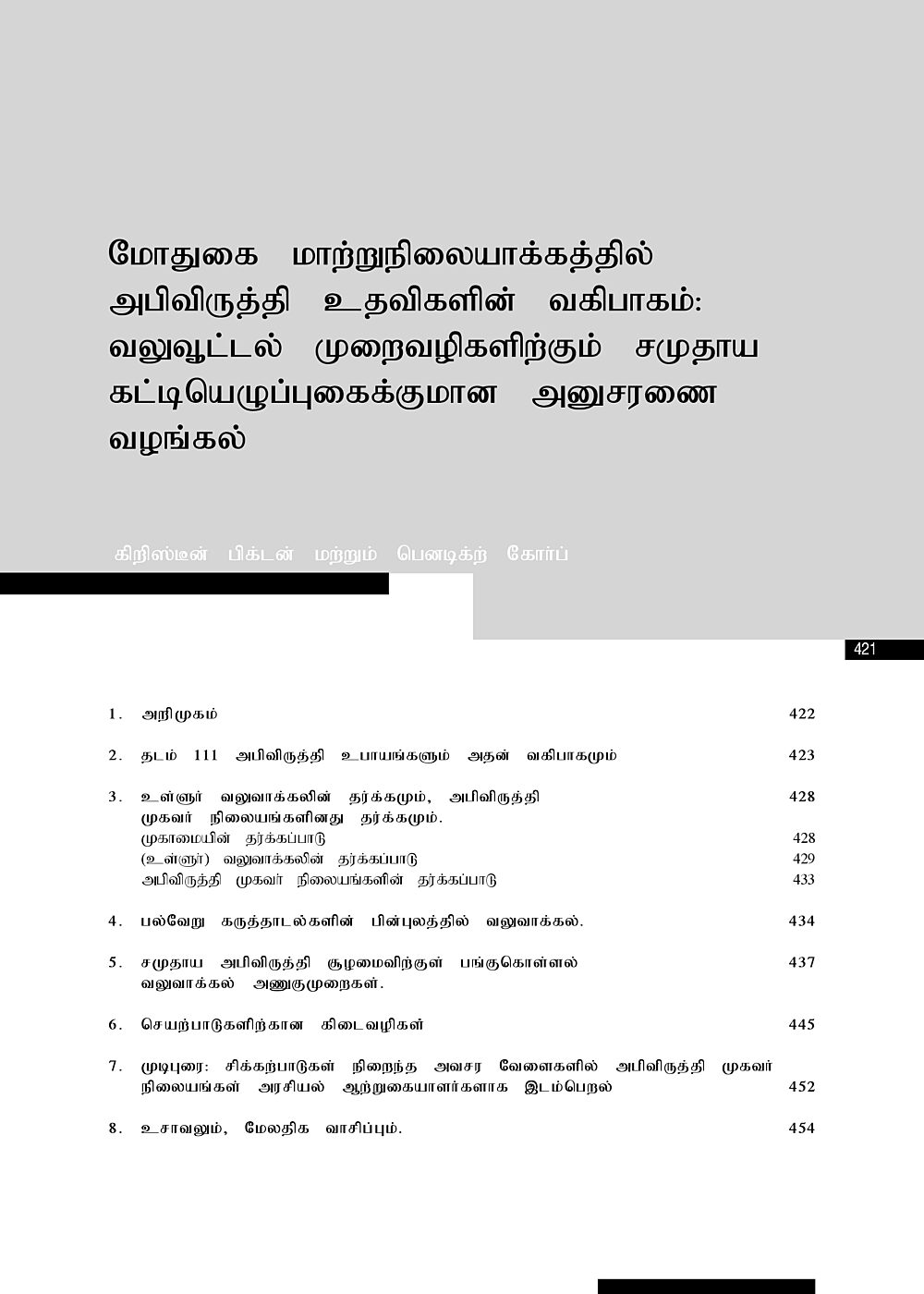Our Library
Explore our publications, from research papers and series to educational materials, covering all aspects of conflict transformation and peace promotion.

Трансформация межкультурных конфликтов в наше сложное времяHandbook Article
[Абстрактный машинный перевод] Основное внимание уделяется трем различным способам воздействия культуры на конфликты: культура как линза, которая облегчает или блокирует эффективное общение; культура и мир рассматривают различия как предмет конфликтов; конфликты, связанные с идентичностью и признанием, как аспекты культурных различий. Автор обсуждает проблемы и конкретные рекомендации для проектирования процессов в культурно-сложных конфликтах.
- Year2007
- Author(s)Michelle LeBaron

Трансформация конфликтов посредством государственной реформыHandbook Article
[Аннотация машинный перевод] Исследует значение государственной реформы для преобразования раздираемых войной территорий. Автор представляет три стратегических подхода: стратегии участия (т.е. демократизация, укрепление гражданского общества, диалог); институциональное строительство и институциональная реформа (т.е. федерализация, децентрализация, конституционная и судебная реформа); и потребности безопасности (например, права человека, безопасность человека). (переработано для печатного издания 2004 г.)
- Year2007
- Author(s)Günter Bächler

රාජ්ය ප්රතිසංස්කරණ මගින් ගැටුම් ව්යාවර්තනයHandbook Article
[වියුක්ත යන්ත්ර-පරිවර්තනය] යුද්ධයෙන් විනාශ වූ ප්රදේශ පරිවර්තනය කිරීම සඳහා රාජ්ය ප්රතිසංස්කරණයේ වැදගත්කම ගවේෂණය කරයි. කතුවරයා උපායමාර්ගික ප්රවේශයන් තුනක් ඉදිරිපත් කරයි: සහභාගීත්ව උපායමාර්ග (එනම් ප්රජාතන්ත්රීයකරණය, සිවිල් සමාජය ශක්තිමත් කිරීම, සංවාදය); ආයතන ගොඩනැගීම සහ ආයතනික ප්රතිසංස්කරණ (එනම් ෆෙඩරල්කරණය, විමධ්යගතකරණය, ව්යවස්ථාමය හා අධිකරණ ප්රතිසංස්කරණ); සහ ආරක්ෂක අවශ්යතා (එනම් මානව හිමිකම්, මානව ආරක්ෂාව). (2004 මුද්රණ සංස්කරණය සඳහා සංශෝධනය කරන ලදි)
- Year2007
- Author(s)Günter Bächler

அரசு சீர்திருத்தத்தினூடாக மோதுகையை மாற்றுநிலைப்படுத்தல்Handbook Article
[சுருக்கம் இயந்திரம்-மொழிபெயர்க்கப்பட்டுள்ளது] போரினால் பாதிக்கப்பட்ட பகுதிகளை மாற்றுவதற்கான அரசு சீர்திருத்தத்தின் முக்கியத்துவத்தை ஆராய்கிறது. ஆசிரியர் மூன்று மூலோபாய அணுகுமுறைகளை முன்வைக்கிறார்: பங்கேற்பு உத்திகள் (அதாவது ஜனநாயகமயமாக்கல், சிவில் சமூகத்தை வலுப்படுத்துதல், உரையாடல்); நிறுவன கட்டிடம் மற்றும் நிறுவன சீர்திருத்தம் (அதாவது கூட்டாட்சி, பரவலாக்கம், அரசியலமைப்பு மற்றும் நீதி சீர்திருத்தம்); மற்றும் பாதுகாப்பு தேவைகள் (அதாவது மனித உரிமைகள், மனித பாதுகாப்பு). (2004 அச்சு பதிப்பிற்காக திருத்தப்பட்டது)
- Year2007
- Author(s)Günter Bächler

«Ястребы» и «голуби» в миротворчестве и концепция разрешения конфликтаHandbook Article
[Аннотация машинный перевод] Обсуждается двойная цель - контролировать насилие при восстановлении отношений сотрудничества, что требует интеграции академических подходов в миротворческую практику. Авторы подчеркивают важность теории разрешения конфликтов для миротворцев, комментируя области ее применения и удовлетворяя будущие потребности миротворческой деятельности. (переработано для печатного издания 2004 г.)
- Year2007
- Author(s)Wibke Hansen, Oliver Ramsbotham, Tom Woodhouse

උකුස්සෝ සහ පරෙවියෝ: සාම සාධනය සහ ගැටුම් නිරාකරණයHandbook Article
[වියුක්ත යන්ත්ර පරිවර්තනය] සමුපකාර සබඳතා නැවත ගොඩනැංවීමේදී ප්රචණ්ඩත්වය පාලනය කිරීමේ ද්විත්ව ඉලක්කය සාකච්ඡා කරයි, එමඟින් සාම ප්රවේශයන් සමඟ අධ්යයන ප්රවේශයන් ඒකාබද්ධ කළ යුතුය. සාම සාධක භටයින් සඳහා ගැටුම් නිරාකරණ සිද්ධාන්තයේ අදාළත්වය, යෙදුම් ක්ෂේත්ර පිළිබඳව අදහස් දැක්වීම සහ අනාගත සාම සාධක අවශ්යතා සපුරාලීම කතුවරුන් විසින් ඉස්මතු කරයි. (2004 මුද්රණ සංස්කරණය සඳහා සංශෝධනය කරන ලදි)
- Year2007
- Author(s)Wibke Hansen, Oliver Ramsbotham, Tom Woodhouse

விப்கி ஹான்சன், ஒலிவர் ரம்ஸ் பொதாம், ரொம் வூட்ஹவுஸ் வல்லூறுகளும் புறாக்களும்: சமாதானத்தை பேணிநடைமுறைப்படுத்தலும் மோதுகைக் தீர்வும்Handbook Article
[சுருக்கம் இயந்திரம்-மொழிபெயர்க்கப்பட்ட] கூட்டுறவு உறவுகளை மீண்டும் கட்டியெழுப்பும்போது வன்முறையைக் கட்டுப்படுத்துவதற்கான இரட்டை இலக்கைப் பற்றி விவாதிக்கிறது, இது கல்வி அணுகுமுறைகளை அமைதி காக்கும் நடைமுறையுடன் ஒருங்கிணைக்க வேண்டும். அமைதி காக்கும் படையினருக்கான மோதல் தீர்வுக் கோட்பாட்டின் பொருத்தத்தை ஆசிரியர்கள் எடுத்துக்காட்டுகின்றனர், பயன்பாட்டுப் பகுதிகள் குறித்து கருத்துத் தெரிவிப்பது மற்றும் எதிர்கால அமைதி காக்கும் தேவைகளை நிவர்த்தி செய்வது. (2004 அச்சு பதிப்பிற்காக திருத்தப்பட்டது)
- Year2007
- Author(s)Wibke Hansen, Oliver Ramsbotham, Tom Woodhouse

Роль помощи развитию в трансформации конфликта: расширение полномочий граждан и укрепление общинHandbook Article
[Аннотация машинный перевод] Подчеркивает роль помощи в целях развития для структурных аспектов миростроительства. Исследуя взаимосвязь между участием, расширением прав и возможностей и трансформацией конфликта, авторы критически обсуждают потенциал общих подходов, основанных на участии, на уровне сообщества и их влияние на трансформацию конфликта на местном уровне. (переработано для печатного издания 2004 г.).
- Year2007
- Author(s)Christine Bigdon, Benedikt Korf

ගැටුම් ව්යාවර්තනයෙහිලා සංවර්ධන ආධාරවල භූමිකාව: බලගැන්වුම් ක්රියාවලි පහසු කිරීම සහ ප්රජාව ගොඩනැංවීමHandbook Article
[වියුක්ත යන්ත්ර පරිවර්තනය] සාමය ගොඩනැගීමේ ව්යුහාත්මක අංශ සඳහා සංවර්ධන ආධාරවල කාර්යභාරය ඉස්මතු කරයි. සහභාගීත්වය, සවිබල ගැන්වීම සහ ගැටුම් පරිවර්තනය අතර ඇති සම්බන්ධතාවය ගවේෂණය කරමින් කතුවරුන් ප්රජා මට්ටමින් පොදු සහභාගීත්ව ප්රවේශයන්හි විභවය සහ ප්රාදේශීය මට්ටමින් ගැටුම් පරිවර්තනය සඳහා ඔවුන් දක්වන බලපෑම විවේචනාත්මකව සාකච්ඡා කරයි. (2004 මුද්රණ සංස්කරණය සඳහා සංශෝධනය කරන ලදි).
- Year2007
- Author(s)Christine Bigdon, Benedikt Korf

மோதுகை மாற்றுநிலையாக்கத்தில் அபிவிருத்தி உதவிகளின் வகிபாகம்: வலுவூட்டல் முறைவழிகளிற்கும் சமுதாய கட்டியெழுப்புகைக்குமான அனுசரணை வழங்கல்Handbook Article
[சுருக்கம் இயந்திரம்-மொழிபெயர்க்கப்பட்டுள்ளது] அமைதி கட்டமைப்பின் கட்டமைப்பு அம்சங்களுக்கான மேம்பாட்டு உதவியின் பங்கை எடுத்துக்காட்டுகிறது. பங்கேற்பு, அதிகாரமளித்தல் மற்றும் மோதல் உருமாற்றம் ஆகியவற்றுக்கு இடையிலான உறவை ஆராய்ந்து, ஆசிரியர்கள் சமூக மட்டத்தில் பொதுவான பங்கேற்பு அணுகுமுறைகளின் திறனையும் உள்ளூர் மட்டத்தில் மோதல் மாற்றத்திற்கான அவற்றின் தாக்கத்தையும் விமர்சன ரீதியாக விவாதிக்கின்றனர். (2004 அச்சு பதிப்பிற்காக திருத்தப்பட்டது).
- Year2007
- Author(s)Christine Bigdon, Benedikt Korf